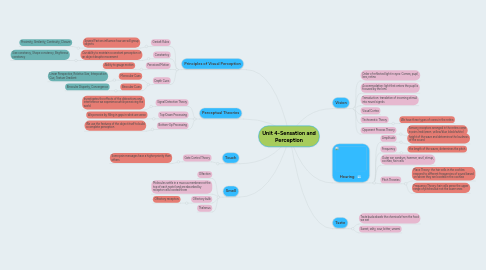
1. Touch
1.1. Gate Control Theory
1.1.1. Some pain messages have a higher priority than others
2. Smell
2.1. Olfaction
2.2. Molecules settle in a mucous membrane at the top of each nostril and are absorbed by receptor cells located there
2.3. Olfactory bulb
2.3.1. Olfactory receptors
2.4. Thalamus
3. Perceptual Theories
3.1. Signal Detection Theory
3.1.1. Investigates the effects of the distractions and interference we experience while perceiving the world
3.2. Top-Down Processing
3.2.1. We perceive by filling in gaps in what we sense
3.3. Bottom-Up Processing
3.3.1. We use the features of the object itself to build a complete perception
4. Principles of Visual Perception
4.1. Gestalt Rules
4.1.1. Several Factors influence how we will group objects
4.1.1.1. Proximity, Similarity, Continuity, Closure
4.2. Constantcy
4.2.1. Our ability to maintain a constant perception of an object despite movement
4.2.1.1. Size constancy, Shape constancy, Brightness constancy
4.3. Perceived Motion
4.3.1. Ability to gauge motion
4.4. Depth Cues
4.4.1. Monocular Cues
4.4.1.1. Linear Perspective, Relative Size, Interposition Cue, Texture Gradient
4.4.2. Binocular Cues
4.4.2.1. Binocular Disparity, Convergence
5. Vision
5.1. Order of reflected light in eyes: Cornea, pupil, lens, retina
5.2. Accommodation: light that enters the pupil is focused by the lens
5.3. Transduction: translation of incoming stimuli into neural signals
5.4. Visual Cortex
5.5. Trichromatic Theory
5.5.1. We have three types of cones in the retina
5.6. Opponent Process Theory
5.6.1. Sensory receptors arranged in the retina come in pairs (red/green, yellow/blue, black/white)
6. Hearing
6.1. Amplitude
6.1.1. height of the wave and determines the loudness of the sound
6.2. Frequency
6.2.1. the length of the waves, determines the pitch
6.3. Outer ear, eardrum, hammer, anvil, stirrup, cochlea, hair cells
6.4. Pitch Theories
6.4.1. Place Theory: the hair cells in the cochlea respond to different frequencies of sound based on where they are located in the cochlea
6.4.2. Frequency Theory: hair cells sense the upper range of pitches but not the lower ones
